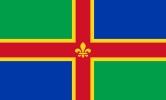Haverholme Priory
 Ruins of Haverholme Priory | |
| Monastery information | |
|---|---|
| Order | Cistercian 1137-1139 Gilbertine 1139-1538 |
| Established | 1137, 1139 |
| Disestablished | 1538 |
| Dedicated to | St Mary |
| People | |
| Founder(s) | Alexander, Bishop of Lincoln |
| Architecture | |
| Status | Monastery rebuilt as a house in the 1780s and 1830s, now ruined |
| Heritage designation | Scheduled Monument 1004984 Grade II listed building 1360563 |
| Site | |
| Location | Ewerby and Evedon, North Kesteven, Lincolnshire |
| Coordinates | 53°01′51″N 0°20′57″W / 53.030800°N 0.34930122°W |
Haverholme Priory was a monastery in Lincolnshire, England. Its remains are situated 4 miles (6 km) north-east from the town of Sleaford and less than 1 mile (1.6 km) south-west from the village of Anwick.[1]
Foundation
In 1137 Alexander, Bishop of Lincoln offered the site of Haverholme Priory to the Cistercian monks of Fountains Abbey. After two years of construction the order rejected the site and instead established Louth Park Abbey. Haverholme was offered to Gilbert of Sempringham and his Gilbertine order who sent nuns and brothers from Sempringham to inhabit the new buildings of what was to be a double monastery.[2]
Gilbertine operation

The Gilbertines also inherited the responsibility for keeping the neighbouring fens drained, and to maintain a foot ferry to Sleaford across the River Slea at Ewerby Waith. They were however summoned to account in 1316 when it fell into disrepair. They were summoned again in 1360 when Alice Everingham, daughter of John de Everingham, who was supposed to have taken vows, fled from the Priory, only to be hunted down and recaptured. She complained to the Bishop of the time that she had never taken vows and she was being held against her will, so he ordered her to be released.
It is rumoured that in 1164 Thomas Becket hid at Haverholme during one of his arguments with the King.[2]
Dissolution and subsequent history

Henry VIII dissolved the Priory in 1538[2] and it had various owners for the next two and a half centuries. It was inherited by the Finch-Hatton family. George Finch-Hatton, 10th Earl of Winchilsea and 5th Earl of Nottingham rebuilt it in 1830. It was used as a family home by the Finch-Hatton family for almost a century but by the early 1920s it was up for sale.[3][4] Haverholme was sold in 1926 to an American woman who had most of it dismantled, stone by stone, to be rebuilt in America. The cargo was on the dock in Liverpool when the buyer became a victim in a train crash. Eventually the stones, never shipped to America, were used to build new docks.[5]
One casualty of this[clarification needed] was the Sleaford Canal locks, which also fell into disuse, effectively closing the canal.
The present ruin is the remains of a Gothic building built around 1835 to designs by the architect Henry Edward Kendall. This was a rebuild of an earlier house dating from 1780. The ruins are now a Grade II listed building[6] and designated Ancient Monument.[7]
References
- ^ Historic England. "Haverholme Priory (351056)". Research records (formerly PastScape). Retrieved 12 November 2014.
- ^ a b c Page, William, ed. (1906). A History of the County of Lincoln: Volume 2 ('Houses of the Gilbertine order: The priory of Haverholme'). London. p. 187-8. Retrieved 16 May 2016.
{{cite book}}: CS1 maint: location missing publisher (link) - ^ The Estate Market: Haverholme Priory: Sporting Property. The Times, 19 August 1921, p. 15, col. G (first paragraph).
- ^ "Haverholme Priory". The Times, 31 August 1921, p. 18, columns A and B.
- ^ "Denys Finch Hatton's Boyhood Home", karenblixen.com
- ^ Historic England. "Haverholme Priory (Grade II) (1360563)". National Heritage List for England. Retrieved 29 June 2016.
- ^ Historic England. "Haverholme Priory scheduling (1004984)". National Heritage List for England. Retrieved 29 June 2016.



